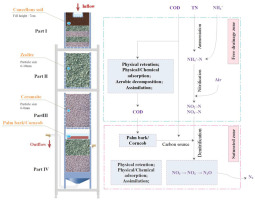当前位置:
X-MOL 学术
›
Chemosphere
›
论文详情
Our official English website, www.x-mol.net, welcomes your
feedback! (Note: you will need to create a separate account there.)
A comparative study on the use of palm bark as a supplementary carbon source in partially saturated vertical constructed wetland: Organic matter characterization, release-adsorption kinetics, and pilot-scale performance.
Chemosphere ( IF 8.1 ) Pub Date : 2020-04-02 , DOI: 10.1016/j.chemosphere.2020.126663 Yang-Rui Huang 1 , Qi-Qi Liu 1 , Yin-Zheng Fan 2 , Huai-Zheng Li 3
Chemosphere ( IF 8.1 ) Pub Date : 2020-04-02 , DOI: 10.1016/j.chemosphere.2020.126663 Yang-Rui Huang 1 , Qi-Qi Liu 1 , Yin-Zheng Fan 2 , Huai-Zheng Li 3
Affiliation

|
In this study, a comparative investigation of palm bark and corncob (a well-investigated material) for enhancing nitrogen removal efficiency in partially saturated vertical constructed wetland (PSVCW) was performed to evaluate an effective and cost-effective supplementary carbon source. The characteristics of the released organic matter and the release processes were analyzed through optical property characterization and a first-order release-adsorption model, respectively, and the nitrogen removal performance was evaluated in a series of pilot-scale PSVCWs. Results showed that the amount of organic matter released per unit mass of corncob was larger than that released per unit mass of palm bark under the same pretreatment conditions (control, heat, and alkaline pretreatment). The organic matter released from corncob has a higher apparent molecular weight and a higher degree of aromatic condensation than those of the organic matter released from palm bark, whereas the organic matter released from palm bark has higher and more stable bioavailability. Moreover, palm bark showed a more significant improvement of release capacity with the heat and alkaline pretreatment methods. Pilot-scale studies revealed that PSVCW using palm bark as the supplementary carbon source has a longer replacement cycle and higher total nitrogen (TN) removal efficiency than that using corncob, indicating that palm bark can be considered an effective and inexpensive supplementary carbon source. This study provides initial guidance for the ongoing research on supplementary carbon sources for improving nitrogen removal efficiency in constructed wetlands.
中文翻译:

在部分饱和的垂直人工湿地中使用棕榈树皮作为补充碳源的比较研究:有机物表征,释放-吸附动力学和中试规模性能。
在这项研究中,进行了棕榈树皮和玉米芯(一种经过充分研究的材料)的对比研究,以提高部分饱和的垂直人工湿地(PSVCW)中的氮去除效率,以评估一种有效且具有成本效益的补充碳源。分别通过光学性质表征和一阶释放-吸附模型对释放有机物的特性和释放过程进行了分析,并在一系列中试规模的PSVCW中评估了脱氮性能。结果表明,在相同的预处理条件下(对照,加热和碱性预处理),每单位质量玉米芯释放的有机物的量大于每单位质量棕榈树皮释放的有机物的量。与从棕榈树皮释放的有机物相比,从玉米芯释放的有机物具有更高的表观分子量和更高的芳族缩合度,而从棕榈树皮释放的有机物具有更高且更稳定的生物利用度。此外,通过加热和碱性预处理方法,棕榈树皮显示出更大的释放能力改善。中试研究表明,与使用玉米芯相比,使用棕榈树皮作为补充碳源的PSVCW具有更长的置换周期和更高的总氮(TN)去除效率,这表明棕榈树皮可以被视为一种有效且廉价的补充碳源。
更新日期:2020-04-03
中文翻译:

在部分饱和的垂直人工湿地中使用棕榈树皮作为补充碳源的比较研究:有机物表征,释放-吸附动力学和中试规模性能。
在这项研究中,进行了棕榈树皮和玉米芯(一种经过充分研究的材料)的对比研究,以提高部分饱和的垂直人工湿地(PSVCW)中的氮去除效率,以评估一种有效且具有成本效益的补充碳源。分别通过光学性质表征和一阶释放-吸附模型对释放有机物的特性和释放过程进行了分析,并在一系列中试规模的PSVCW中评估了脱氮性能。结果表明,在相同的预处理条件下(对照,加热和碱性预处理),每单位质量玉米芯释放的有机物的量大于每单位质量棕榈树皮释放的有机物的量。与从棕榈树皮释放的有机物相比,从玉米芯释放的有机物具有更高的表观分子量和更高的芳族缩合度,而从棕榈树皮释放的有机物具有更高且更稳定的生物利用度。此外,通过加热和碱性预处理方法,棕榈树皮显示出更大的释放能力改善。中试研究表明,与使用玉米芯相比,使用棕榈树皮作为补充碳源的PSVCW具有更长的置换周期和更高的总氮(TN)去除效率,这表明棕榈树皮可以被视为一种有效且廉价的补充碳源。











































 京公网安备 11010802027423号
京公网安备 11010802027423号